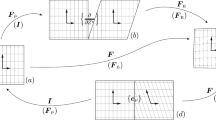Conclusions
-
1.
Generalization of the experimental data on mobility of dislocations and their capacity to multiply in the process of plastic deformation permits us to describe the basic macroscopic phenomena of plastic flow of crystalline solids, and moreover a good quantitative correspondence of calculation curves of the temperature dependence of fluid-flow stresses with experimental curves has been observed.
For crystals distinguished by a high sensitivity of the dislocation velocity to the effective stress, at low tension rates the differences between the magnitudes of the intensity of dislocation multiplication at different low temperatures apparently does not lead to any significant distortion of the lower limit of the yield point.
-
2.
The differential equation found for the mechanical state of the crystal allows us to obtain three special solutions, corresponding to uniaxial deformation with constant velocity, creep, and stress relaxation. The indicated solutions are numerically integrated. In each case series of corresponding curves are obtained.
-
3.
In order to explain the properties of the initial stages of plastic flow within the framework of the calculation model, it is not necessary to introduce concepts of a process of simultaneous freeing of many dislocations or of their breaking away from the atmosphere of impurity atoms. The initial stages of plastic flow can be described by the basic physical parameters characterizing the external conditions and properties of the material in dependence on time.
Similar content being viewed by others
Literature Cited
W. D. Johnston and J. J. Gilman, J. Appl. Phys.,30, No. 2, 129 (1959).
G. T. Hahn, Acta. Metallurg.,10, No. 8, 727 (1962).
W. D. Johnston, J. Appl. Phys.,33, No. 9 (1962).
V. G. Govorkov, V. L. Indenbom, V. S. Papkov, and V. R. Regel', in: The Mechanism of Metal Failure [in Russian], Naukova Dumka, Kiev (1966).
Yu. V. Mil'man and V. I. Trefilov, in: The Mechanism of Metal Failure [in Russian], Naukova Dumka, Kiev (1966).
P. P. Gillis and J. J. Gilman, J. Appl. Phys.,36, No. 11, 3370–3386 (1965).
A. H. Cottrell, in: Structure and Mechanical Properties of Metals [Russian translation], Metallurgizdat, Moscow (1967), p. 210.
A. H. Cottrell, Dislocations and Plastic Flow in Crystals [Russian translation], Metallurgizdat, Moscow (1958).
A. Chandhuri, J. Patel, and L. Rubin, J. Appl. Phys.,33, No. 9, 2736 (1962).
M. N. Cabler, Phys. Rev.,131, No. 54 (1963).
T. Suzuki and H. Kojima, Acta Metallurg.,14, No. 8, 913 (1966).
D. F. Stein and J. R. Low, J. Appl. Phys.,31, No. 2, 362 (1960).
J. S. Erickson, J. Appl. Phys.,33, No. 8 (1962).
R. Jaffe and G. Hahn, in: Structure and Mechanical Properties of Metals [Russian translation], Metallurgiya, Moscow (1967).
D. P. Pope, T. Vreeland Jr., and D. S. Wood, J. Appl. Phys.,38, No. 10, 4011 (1967).
W. F. Greenman, T. Vreeland Jr., and D. S. Wood, J. Appl. Phys.,38, No. 9, 3595 (1967).
R. W. Ronde and C. H. Pitt, J. Appl. Phys.,38, No. 2, 876 (1967).
E. Yu. Gutmanas, É. M. Nadgornyi, and A. V. Stepanov, Fizika Tverd. Tela,5, No. 2, 1021 (1963).
V. N. Rozhanskii, V. M. Stepanova, E. V. Parvova, and A. A. Predvoditelev, Fizika Tverd. Tela,5, No. 2, 634 (1963).
V. B. Pariiskii, S. V. Lubenets, and V. I. Startsev, Fizika Tverd. Tela,8, No. 4, 1227 (1966).
J. E. Hanafee and S. V. Radcliffe, J. Appl. Phys.,38, No. 11, 4284 (1967).
J. E. Dorn, J. E. Mitchell, and F. Hauser, Experimental Mechanics,5, No. 11, 3 (1965).
F. F. Lavren'ev, O. P. Salita, and V. I. Startsev, in: The Mechanism of Metal Failure [in Russian], Naukova Dumka, Kiev (1966), p. 27.
Ya. I. Frenkel' and T. A. Kontorova, Zh. Éksp. Teor. Fiz., No. 8, 89 (1938).
J. D. Echelby, Proc. Phys. Soc.,A62, 307 (1949).
J. Gilman, UFN,80, No. 3, 455 (1963).
J. J. Gilman, J. Appl. Phys.,36, No. 10, 3195 (1965).
Van Buren, Defects in Crystals [Russian translation], IL, Moscow (1963).
É. M. Nadgornyi and B. I. Smirnov, Fiz. Tverd. Tela, No. 8, 2048 (1966).
E. Schmid and W. Boas, Kristallplastizitat, Springer, Berlin (1935).
Y. Nakada and A. S. Keh, Acta Metallurg.,14, No. 8, 961 (1966).
J. Wirtman and J. R. Wirtman, Physical Metal Science [Russian translation], Vol. 3, Mir, Moscow (1968), p. 155.
Additional information
Institute of Strength of Materials, Academy of Sciences of the Ukrainian SSR, Kiev. Translated from Problemy Prochnosti, No. 1, pp. 71–77, July, 1969.
Rights and permissions
About this article
Cite this article
Krasovski, A.Y. Dislocation dynamics and plastic shear in crystalline solids communication 1. Strength Mater 1, 67–73 (1969). https://doi.org/10.1007/BF01675439
Received:
Issue Date:
DOI: https://doi.org/10.1007/BF01675439




